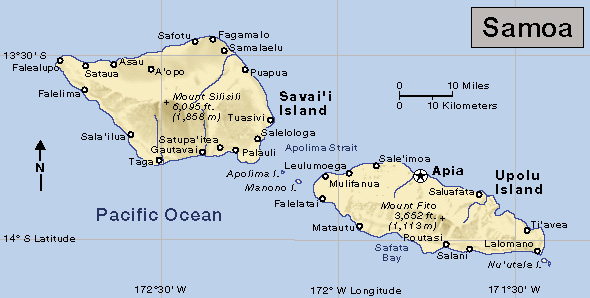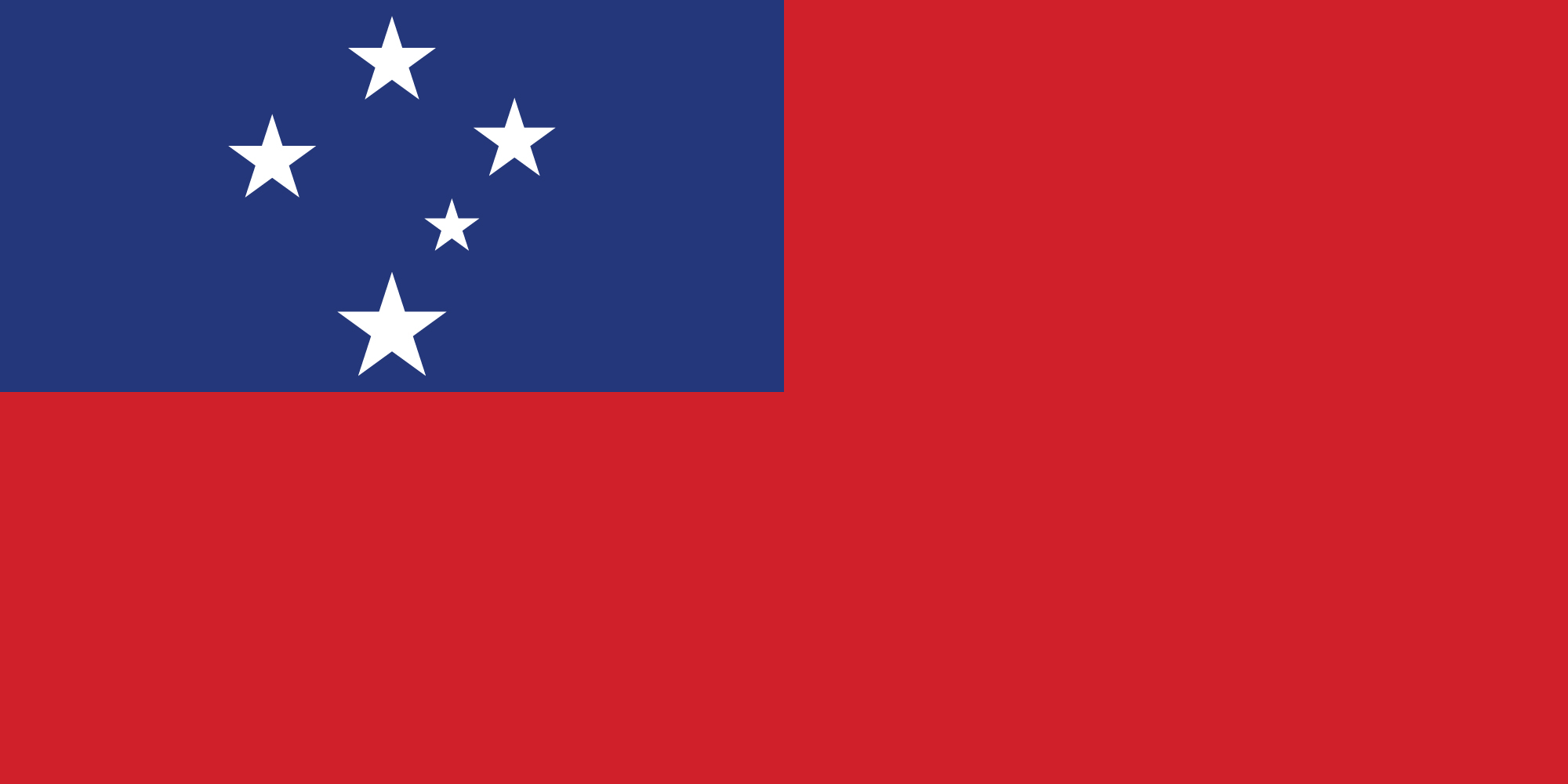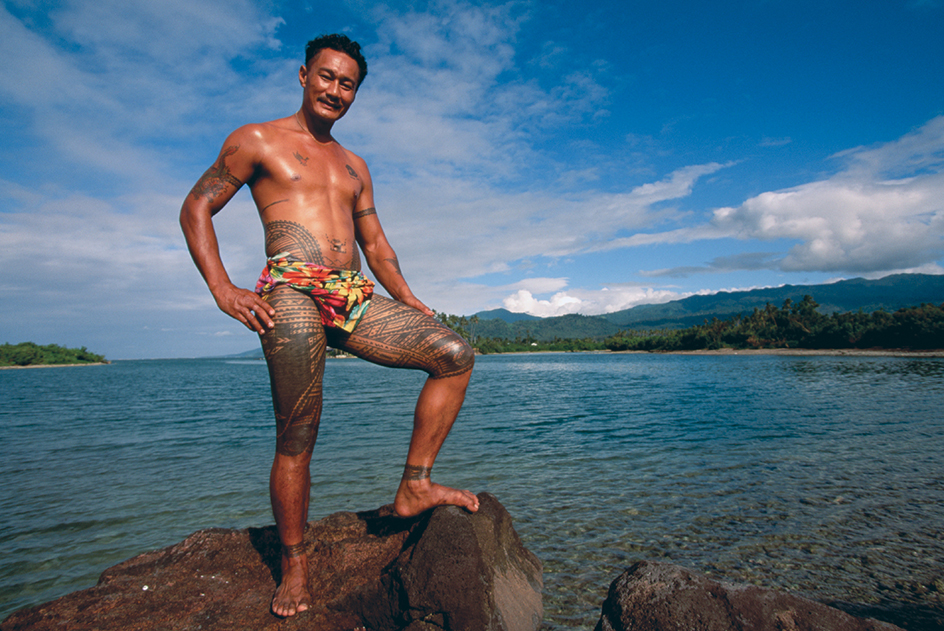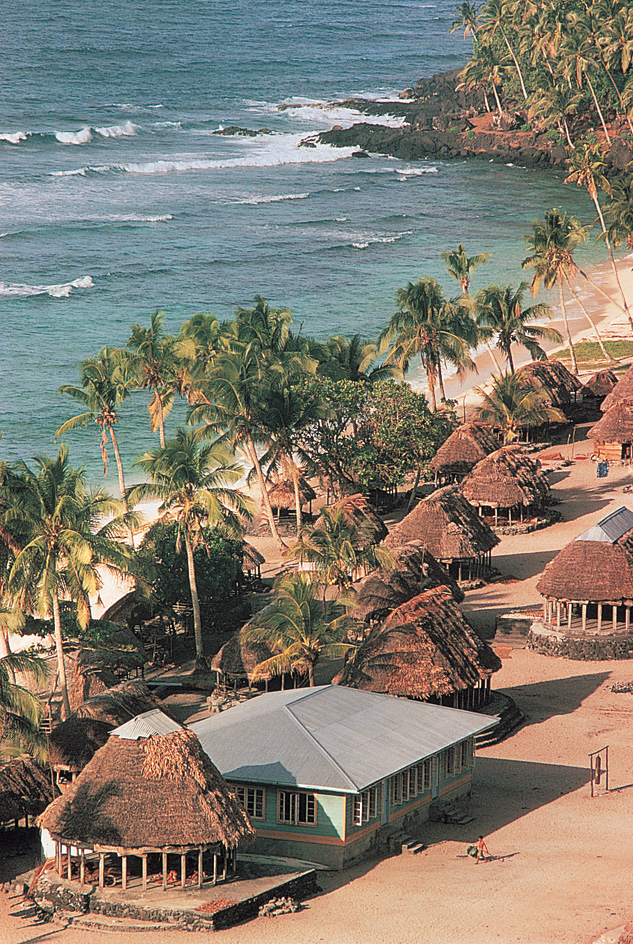Samoa, << suh MOH uh, >> is an independent island country in the South Pacific Ocean. It lies in the western part of the Samoa Islands chain about 1,700 miles (2,740 kilometers) northeast of New Zealand. American Samoa, a United States territory, occupies the eastern part of the chain (see American Samoa). Samoa is one of the smallest countries. It consists of two main islands, Upolu and Savai’i, and several smaller islands. Apia, a city that has about 37,000 people, is the capital and only city.

Samoans are Polynesians. Most live by raising their own food on small plots of land. 
Polynesians have lived in Samoa for at least 2,000 years. The first Europeans landed there in the 1700’s, and Germany took control in 1900. During World War I (1914-1918), New Zealand occupied the islands. It ruled them until the islands gained independence as Western Samoa in 1962. The noted writer Robert Louis Stevenson lived in Samoa for several years. He died there and was buried near Apia in 1894. Stevenson’s house, which was called Vailima, is now a museum.
Government.
Samoa’s parliament, called the Fono, elects a head of state to a five-year term. Malietoa Tanumafili II, Samoa’s first head of state, held office for life from the nation’s independence in 1962 to his death on May 11, 2007.
Loading the player...Samoa national anthem
Voters elect the 51 members of the Fono to five-year terms. If women win less than 10 percent of these seats, one or more additional seats may be added. Any additional seats are filled by the female candidates who received the most votes but did not win their constituencies. The Fono members elect the prime minister. The prime minister selects a cabinet from among Fono members. All people 21 years old and older may vote.
The prime minister and cabinet actually run the government of Samoa. Laws passed by the Fono do not go into effect until the head of state approves them. A pulenu’u (head chief) is appointed to represent the government in each village.
People.
Most Samoans are of full Polynesian descent. About 10 percent of the people are of mixed Samoan and European descent. A few Europeans, Chinese, and people from other Pacific islands live in Samoa. The people speak Samoan, a Polynesian language. Many Samoans also speak English.

Samoans live simply, much as their ancestors did. Samoan life centers around the family. The people live with their relatives in extended family groups that are called aiga. The aiga elects a matai who serves as head of the family.
Many people live in open-sided fale (houses) that have a thatched roof supported by poles. But cement-block houses with sheet-metal roofs are becoming more common. Most Samoan men wear a shirt and a lava-lava, a piece of cloth wrapped around the waist like a skirt. Most of the women wear a long lava-lava and an upper garment called a puletasi.

Samoans enjoy singing and dancing, which serve as both a form of recreation and a method of handing down history and tradition. Samoans also play their own version of cricket, a game they learned from the English missionaries. They play cricket with teams that may have from 10 to 300 players, compared to 11 players in a normal cricket game.
Loading the player...Samoan traditional song
Almost all Samoans are Christians. The most important religious groups in the country are the Congregational, Methodist, and Roman Catholic churches.
Samoa provides good medical care, and the people are generally healthy. Most districts have government hospitals that provide free care.
Almost all Samoans can read and write. Education is free. Children are required to attend elementary school. The government operates elementary schools in most villages and also has a few high schools. Many children attend mission schools. Many Samoan schools use distance learning programs conducted on radio, television, and the Internet. The National University of Samoa is in Apia. Some Samoan students go overseas for further schooling.
Land.
The islands of Samoa were formed by erupting volcanoes. A volcano on Savai’i is still active. It last erupted from 1905 to 1911, covering part of the island with lava rock that is still bare. The islands are fringed with coral reefs.
The island shores are lined with tall, graceful coconut palm trees. The rocky, reddish-brown soil near the coasts is fertile enough to produce bananas; taro, a plant with an edible underground stem; and cacao, a tree whose seeds are used to make chocolate and cocoa. Further inland, heavy rains have leached the soil (dissolved the minerals and washed them away). Few food crops can grow there. Tropical rain forests cover the high volcanic peaks at the center of the islands.
The climate is tropical and humid, but the southeast trade winds make it mild. Temperatures seldom rise above 85 °F (29 °C) or fall below 75 °F (24 °C). Rainfall ranges from about 70 inches (180 centimeters) a year on the northwest coast to over 150 inches (381 centimeters) in the southeast. The most pleasant months are from May to September, when the temperatures and rainfall are lowest.
Economy
in Samoa is largely based on agriculture. Over half of the country’s workers are farmers. Coconuts are the country’s leading agricultural product and a leading export. Bananas, cacao, papayas, pineapples, taro, and yams are also grown. Samoans raise cattle, chickens, and pigs, and catch fish for food.

Tourism is a growing industry in Samoa. Over 100,000 tourists visit the country each year. Remittances (money sent home) from Samoans working abroad are another important source of national income. The country also receives foreign aid from Australia, Japan, New Zealand, and other countries.
Manufacturing plays a small role in Samoa’s economy. Samoa imports more than it exports. The country imports food and machinery. Samoa exports beer, coconuts and coconut products, and fish products. Samoa’s main trading partners include Australia, China, Fiji, New Zealand, and the United States.
Most Samoan villages are linked by roads. Small boats travel regularly between the islands. Samoa has an international airport on Upolu Island. Oceangoing ships dock at Apia, Samoa’s only port.
History.
People have lived in Samoa for at least 2,000 years, probably coming there from what are now Fiji and Vanuatu. The Samoans drove out invaders from the Tonga Islands and began forming their own nation about 1,000 years ago. Many chiefs ruled the people until a woman, Salamasina, united them in the 1500’s.
Jacob Roggeveen, a Dutch explorer, was the first European to reach the Samoa Islands. He arrived in 1722. But few Europeans visited the islands until the first mission was established in Savai’i in 1830. Once the Samoans accepted the missionaries, whaling and trading ships began making regular stops in the islands.
Two royal families ruled different parts of the Samoa Islands during the mid-1800’s, and they fought among themselves over who would be king. Britain, Germany, and the United States supported rival groups. In 1899, the three countries agreed that Germany and the United States would divide the islands, and Germany took control of the western islands in 1900. Germany improved farm production and also expanded the economy.
In 1914, during World War I, a military force from New Zealand occupied German Samoa. After the war, the League of Nations gave New Zealand a mandate (order) to govern what was then called Western Samoa.
New Zealand’s rule began disastrously. An influenza epidemic struck Western Samoa in 1918, and about one-fifth of the people died. The New Zealand government became more and more unpopular in the 1920’s. Some Samoans joined an organization called the Mau (testimony) movement, which favored Samoan traditions and opposed rule by New Zealand. The Mau movement urged nonviolent resistance. Samoans began to refuse to obey laws or to cooperate with the government. They continued their civil disobedience activities until 1936, when New Zealand officials met some of their demands.
After World War II (1939-1945), the United Nations made Western Samoa a trust territory and asked New Zealand to begin preparing the islands for independence. In 1957, members of the Fono were elected for the first time and Samoan members controlled it. A cabinet headed by a Samoan prime minister gained executive powers in 1959. In 1961, the people voted to accept a new constitution. Western Samoa became independent on Jan. 1, 1962. It joined the Commonwealth of Nations in 1970 and the United Nations in 1976. It changed its name to Samoa in 1997.
In 2011, Samoa changed the time zone to which it belongs to boost trade and tourism with neighboring New Zealand and Australia. It skipped forward from Dec. 29 to Dec. 31 that year by changing to a time zone west of the International Date Line.
The 2021 legislative elections were very close and resulted in a number of court challenges. The opposition party, with support from one independent representative, won enough seats in the Fono to elect its leader as prime minister. Fiame Naome Mata’afa became Samoa’s first woman prime minister.
See also Apia.
